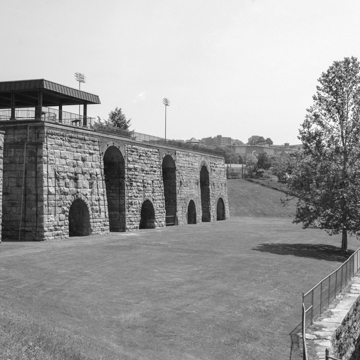These four huge stone blast furnace bases are the only remnants of the massive plant once operated by the Lackawanna Iron and Coal Company, which began here in 1840 as the Scranton, Grant and Company. When the Civil War ended, the plant boasted the largest iron production capacity in the United States. In 1880 these furnaces produced 125,000 tons of pig iron, which was converted in its rolling mill and foundry into T-rails and other end products. However, in a stunning blow to its hometown, Lackawanna Iron and Steel Company (it was renamed in 1891 when it merged with Scranton Steel Company) dismantled the plant in 1902 and moved it to Buffalo, New York, to be closer to the high-grade iron ores coming out of the Mesabi Range. The fate of American industry and their towns was at hand.
You are here
Lackawanna Iron and Coal Company Furnaces
If SAH Archipedia has been useful to you, please consider supporting it.
SAH Archipedia tells the story of the United States through its buildings, landscapes, and cities. This freely available resource empowers the public with authoritative knowledge that deepens their understanding and appreciation of the built environment. But the Society of Architectural Historians, which created SAH Archipedia with University of Virginia Press, needs your support to maintain the high-caliber research, writing, photography, cartography, editing, design, and programming that make SAH Archipedia a trusted online resource available to all who value the history of place, heritage tourism, and learning.


